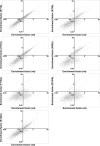Characterisation of aptamer-target interactions by branched selection and high-throughput sequencing of SELEX pools
- PMID: 26163061
- PMCID: PMC4666376
- DOI: 10.1093/nar/gkv700
Characterisation of aptamer-target interactions by branched selection and high-throughput sequencing of SELEX pools
Abstract
Nucleic acid aptamer selection by systematic evolution of ligands by exponential enrichment (SELEX) has shown great promise for use in the development of research tools, therapeutics and diagnostics. Typically, aptamers are identified from libraries containing up to 10(16) different RNA or DNA sequences by 5-10 rounds of affinity selection towards a target of interest. Such library screenings can result in complex pools of many target-binding aptamers. New high-throughput sequencing techniques may potentially revolutionise aptamer selection by allowing quantitative assessment of the dynamic changes in the pool composition during the SELEX process and by facilitating large-scale post-SELEX characterisation. In the present study, we demonstrate how high-throughput sequencing of SELEX pools, before and after a single round of branched selection for binding to different target variants, can provide detailed information about aptamer binding sites, preferences for specific target conformations, and functional effects of the aptamers. The procedure was applied on a diverse pool of 2'-fluoropyrimidine-modified RNA enriched for aptamers specific for the serpin plasminogen activator inhibitor-1 (PAI-1) through five rounds of standard selection. The results demonstrate that it is possible to perform large-scale detailed characterisation of aptamer sequences directly in the complex pools obtained from library selection methods, thus without the need to produce individual aptamers.
© The Author(s) 2015. Published by Oxford University Press on behalf of Nucleic Acids Research.
Figures







Similar articles
-
An improved SELEX technique for selection of DNA aptamers binding to M-type 11 of Streptococcus pyogenes.Methods. 2016 Mar 15;97:51-7. doi: 10.1016/j.ymeth.2015.12.005. Epub 2015 Dec 8. Methods. 2016. PMID: 26678795
-
The Effects of SELEX Conditions on the Resultant Aptamer Pools in the Selection of Aptamers Binding to Bacterial Cells.J Mol Evol. 2015 Dec;81(5-6):194-209. doi: 10.1007/s00239-015-9711-y. Epub 2015 Nov 4. J Mol Evol. 2015. PMID: 26538121
-
A simple method for eliminating fixed-region interference of aptamer binding during SELEX.Biotechnol Bioeng. 2014 Nov;111(11):2265-79. doi: 10.1002/bit.25294. Epub 2014 Jul 14. Biotechnol Bioeng. 2014. PMID: 24895227
-
Implementation of High-Throughput Sequencing (HTS) in Aptamer Selection Technology.Int J Mol Sci. 2020 Nov 20;21(22):8774. doi: 10.3390/ijms21228774. Int J Mol Sci. 2020. PMID: 33233573 Free PMC article. Review.
-
In vitro evolution of chemically-modified nucleic acid aptamers: Pros and cons, and comprehensive selection strategies.RNA Biol. 2016 Dec;13(12):1232-1245. doi: 10.1080/15476286.2016.1236173. Epub 2016 Oct 7. RNA Biol. 2016. PMID: 27715478 Free PMC article. Review.
Cited by
-
Differential binding cell-SELEX method to identify cell-specific aptamers using high-throughput sequencing.Sci Rep. 2019 May 31;9(1):8142. doi: 10.1038/s41598-019-44654-w. Sci Rep. 2019. PMID: 31148584 Free PMC article.
-
Opportunities in the design and application of RNA for gene expression control.Nucleic Acids Res. 2016 Apr 20;44(7):2987-99. doi: 10.1093/nar/gkw151. Epub 2016 Mar 11. Nucleic Acids Res. 2016. PMID: 26969733 Free PMC article. Review.
-
Phased nucleotide inserts for sequencing low-diversity RNA samples from in vitro selection experiments.RNA. 2020 Aug;26(8):1060-1068. doi: 10.1261/rna.072413.119. Epub 2020 Apr 16. RNA. 2020. PMID: 32300045 Free PMC article.
-
Screening and identification of DNA aptamers toward Schistosoma japonicum eggs via SELEX.Sci Rep. 2016 Apr 28;6:24986. doi: 10.1038/srep24986. Sci Rep. 2016. PMID: 27121794 Free PMC article.
-
SELEX tool: a novel and convenient gel-based diffusion method for monitoring of aptamer-target binding.J Biol Eng. 2020 Jan 13;14:1. doi: 10.1186/s13036-019-0223-y. eCollection 2020. J Biol Eng. 2020. PMID: 31956340 Free PMC article.
References
Publication types
MeSH terms
Substances
LinkOut - more resources
Full Text Sources
Other Literature Sources
Miscellaneous

